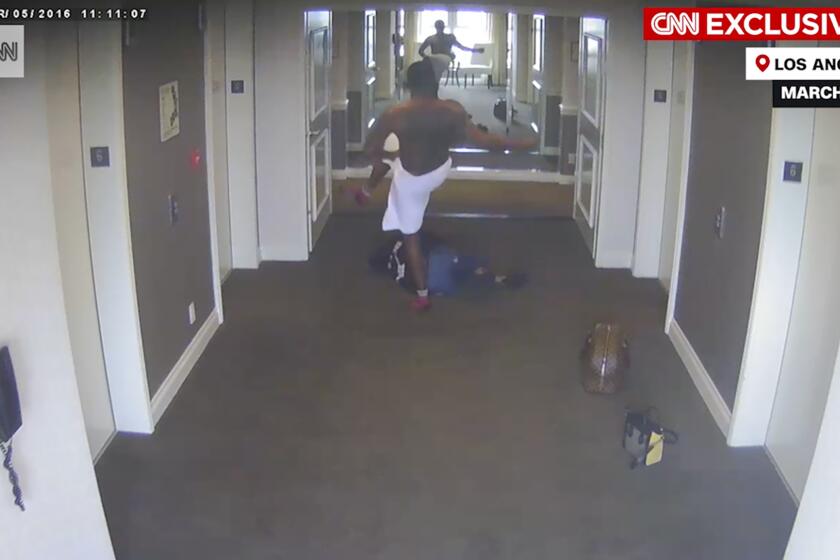POP MUSIC : Mr. Melting Pot : Using his Latino and African American heritage as a springboard to multicultural music, singer Jon Secada is realizing his crossover dreams while promoting integration âbecause thatâs what America is aboutâ
The business of being Jon Secada is being conducted today on Stage 14 at NBCâs Burbank studios, where the 32-year-old Afro Cuban American singer is taping âThe Tonight Show With Jay Leno.â
After that, Secada--who blasted out of nowhere in 1992 with a debut album that has sold 6 million worldwide and a Grammy-winning Spanish-language counterpart that has sold another 400,000--will perform the hit single from his new album, âHeart, Soul & a Voice,â for the NBC late-night show âFriday Night.â After that, thereâs a âmeet and greetâ with fans who won a âMeet Jon Secadaâ contest.
After that, there are pictures to be taken, grateful-sounding thanks to be murmured, flesh to be pressed.
After that . . . well, after that, Jon Secada--handsome, soft-spoken, genial Jon Secada--would be forgiven for bouncing off the walls in his room at Le Parc Hotel.
Not that thatâs likely.
âIâm a workaholic,â Secada says with a shrug.
âHe never complains,â says his agent, Jorge Pinos.
âHe sings from the heart,â says his manager, producer and mentor, Emilio Estefan.
The business of being Jon Secada is especially big business because Secada--as pop singer, songwriter and performer--appeals both to the U.S. mainstream pop audience and the nationâs estimated 22 million Latinos.
âSpanish-speaking people are probably going to be the biggest-growing market in the States,â says Estefan, a Cuban immigrant (like Secada) whose other major client, wife Gloria Estefan, has already carved out a lucrative English-Spanish singing career.
While Secadaâs first album, the 1992 âJon Secada,â buoyed by the huge hit âJust Another Day,â scored with mainstream Anglo audiences, the Spanish-language counterpart, âOtro Dia Mas Sin Verte,â spawned four No. 1 singles on Billboardâs Latin chart and bagged a Grammy for best Latin pop album.
Secada also walked away with best male artist, best new artist and best album in the pop category at last yearâs Premio Lo Nuestro a La Musica Latina, the prestigious Latin equivalent to the Grammys. Whatâs more, a sizable number of English-speaking Anglos appear to have bought âOtro Dia Mas.â
âTo this day,â Secada says, âAnglos tell me that they might not understand what Iâm singing, but thereâs immediately more passion in the Spanish versions of the songs.â
The upshot of all this cross-cultural pollination: Barely 2 1/2 years into his career, Secada has emerged as an enormous star both in the States and in Latin America. (Not to mention Europe, Africa and Asia--his label, SBK Records, says Secadaâs first album was a hit in 20 countries.)
Critical acceptance has not come so smoothly. Secadaâs first album was written off by critics as facile adult-contemporary popcraft. Some mainstream reviews for âHeart, Soul & a Voiceâ have been more positive, but heâs still often faulted for writing unashamedly radio-ready material.
The Timesâ Don Heckman, praising Secadaâs voice as âone of the most flexible . . . in pop,â concludes that the dance-pop orientation of the new album doesnât suit the singer. âSecada has the talent to become a big-time crossover act but on this he doesnât get much opportunity to show it,â he wrote.
The same doubts exist among Latin music critics, who generally marvel at his commercial success but dismiss his artistic value.
Among record buyers, though, about the only demographic Secada hasnât conquered here is the African American audience, and he and his record company are going after it with a vengeance with the new âHeart, Soul & a Voice.â The collection entered the U.S. pop album charts two weeks ago at No. 21.
The album, which Secada says is a truer reflection of his muse than the debut package, pulses with the sweet, sexy grooves of Earth, Wind & Fire, Marvin Gaye and other R&B; titans that the singer, the son of black and Latino exiles from Cuba, favored while growing up in Hialeah, Fla., the largely Latino working-class community north of Miami.
âOn the last album, urban radio really wasnât there,â says Secada, whose grasp of record industry marketing-speak is every bit as fluent as his English and Spanish. âBut this record, yeah, itâs pop, but the flavors are definitely R&B.; The first song, âIf You Go,â already got accepted by urban radio. I really want that.
âIâm Hispanic,â he adds, âbut Iâm also African. My roots are just as African as any black person who was born here. I consider myself a big melting pot of different cultures, which I want to attest to in my music--kind of talk about integration and promote it, because thatâs what America is about.â
Secada realizes his crossover dreams, however earnestly articulated, could be construed as a shameless marketing ploy. âThat was definitely a fear,â he acknowledges. âBut so far, the comments are that the stuff is genuine and sincere. Itâs not that this is put on because Iâm trying to market myself in a certain way. The music speaks for itself.â
*
Secada might still be an unknown in Miami were it not for the Berry Gordy-like ministrations of Emilio Estefan, a tireless promoter of the cityâs rich Cuban American talent base.
During the 1980s, Estefan leveraged the Latin-inflected dance hits of his band, Miami Sound Machine, into a pop-music cottage industry. At its center was MSM lead singer Gloria Estefan, who would later reposition herself as a bilingual pop star, setting the crossover precedent for Secada to exploit a decade later.
In the meantime, Secada, freshly graduated from the University of Miami with a masterâs degree in jazz singing, was teaching at Miami-Dade Community College and playing bar mitzvahs. His ambitions, he admits, didnât extend much beyond that.
âThe horizon for me was to be a working musician, which I was,â Secada says. âTeaching, sessions, nightclubs, whatever. I had a house and I was making a good living. No problem.â
Then college acquaintances of Secada who were members of Miami Sound Machine gave his demo tape to Emilio Estefan.
âThat was the beginning,â Secada says. âAt the time, Emilio really wanted someone besides Gloria to represent and manage--a Miami talent, somebody bilingual.â
Estefan spent five years grooming his protege, immersing Secada in every aspect of the record business, from production to songwriting. âHe didnât rush it,â Secada says. âHe wanted me to start out getting my feet wet, learn about the business, slowly develop a name and a reputation.â
In due course, Secada proved his mettle by co-writing two No. 1 singles for Gloria Estefan--âComing Out of the Darkâ and âCanât Forget You.â He joined her 1991 world tour as a backup singer and was given a featured solo spot in the show.
âGloria wanted to help him,â Emilio Estefan says. â âWhat can I do to help this guy to cross over?â It was a great way to show people who Jon Secada was.â
Thanks to the Estefansâ munificence, Secada had performed in front of 5 million people in five countries before scoring a record deal of his own. Signed, at last, in 1991 to SBK Records, Secada benefited directly from the lessons Estefan had absorbed marketing Miami Sound Machine and then Gloria to the Latin and mainstream pop markets.
âEven though I got signed as an Anglo artist, Emilio, from the beginning, said to the record company, âWe gotta do this stuff bilingual, thereâs a big market, a lot of potential,â â Secada says. âWe didnât intend to record in Spanish necessarily--it was âLetâs pick two songs, see how they do.â So they let me do two Spanish songs, versions of âJust Another Dayâ and âAngelâ on the English album.â
The response to the experiment among Latin radio stations and record buyers was overwhelmingly positive, prompting the recording of the âOtro Dia Masâ Spanish-language version of âJon Secada.â
Says Estefan: âHis market was really the Anglo market, so the crossover for him was really the reverse.â
A fistful of Latin No. 1s and a Grammy later, Secada still marvels at the acceptance: âMy career in Spanish was overnight superstardom in every sense of the word. I didnât know I would get that kind of response from the Latin market. Iâm very happy I did âthe Spanish songs,â because from Day One, weâve had both markets.â
And he means to keep them. âSi Te Vas,â the Spanish version of the new âHeart, Soul & a Voiceâ album, will be released July 12.
Tellingly, Secadaâs first world tour opens Oct. 6, not in the United States but in Mexico City, and is scheduled to hit most of Latin America and the Caribbean before coming to the States early next year. While Secada will play 3,000-5,000-seat venues in the United States, his stature in Latin America allows him to perform in 20,000-seat stadiums.
âExcept Brazil, not much talent goes to these countries,â Secada says. âBut I want to go there because the album did really well, (and to) make a statement of performing in these countries that are part of the Latin American world.â
Even as Secada consolidates his Pan-Latin audience, itâs worth noting that, Spanish lyrics and his own ethnic heritage aside, his music has few obvious Latin influences. Secada, instead, flies world musicâs multicultural flag--he browses through a variety of musical lexicons then binds them to sure-fire grooves. The approach, says agent Pinos, is well-suited to the programming style of Latin radio stations.
âSpanish radio plays all kinds of music,â Pinos says. âA little pop, a little rock, a little salsa.â The song âWhipped,â which opens âHeart, Soul & a Voice,â summarizes Secadaâs ability to synthesize influences.
Leading off with a trenchant R&B; industrial drum track and ominous vocal samples, the song mixes soothing Latin inflections on the verses with explosive gospel-singer choruses. Secada even tosses in a lusty, soul-man âright onâ on the fade-out. âIâm very proud of that song,â he says. âThatâs the direction I want to get into.â
Given his conservatory training and Estefanâs tutelage, there are facets of Secadaâs talent he has probably only begun to explore.
Hollywood, ever alert to the possibilities of a presentable and non-controversial star, has already weighed in with film offers, which Estefan thought it wise to turn down. But with Secadaâs pinup looks, multiracial makeup and bilingualism, he is perfectly positioned to exploit the needs of a music industry now controlled by conglomerates that depend heavily on overseas sales for profits.
Secadaâs Pan-culturalism is perfectly suited to a world in which racial and national boundaries increasingly blur--Americans can claim him as one of their own, but so can Cubans, Portuguese, Costa Ricans, Spaniards and Mexicans. Seen in this context, Secadaâs sudden stardom seems much less unlikely. It also makes an ethnic pop star like Michael Jackson--who, however strong his appeal abroad, will forever be viewed as a U.S. export--look suddenly out of date.
*
This afternoon, the business of being Jon Secada is being conducted in the wings of the âFriday Nightâ set. Ringed by klieg lights, publicists and senior factotums such as Pinos, Secada perches on a stool and waits patiently to be fed rehearsed questions for the showâs interview segment.
The just-wrapped âTonight Showâ taping couldnât have gone much better. Jay Leno introduced Secada as âmy good friend,â and guest Eddie Murphy took time out from flogging âBeverly Hills Cop IIIâ to announce he is a big fan and then lingered on the couch to watch the singer nail âIf You Go.â Now Secada, who has conducted more than 100 interviews in support of this new album, girds himself for another.
âTape is rolling--waiting for speed,â a stage manager barks. âIn three, two . . . â
âThe first thing we want to say is congratulations on your success,â an interviewer off-camera reads from a clipboard. âYour life has changed dramatically. I was wondering if you could tell us a little bit about it.â
âMy life has changed in different ways,â Secada murmurs earnestly. âMainly the pace has changed, but . . . â
âHold it,â says the stage manager, listening to the control booth through his headset. âTheyâre not happy with the spot on his left cheek.â
Pinos steps into the lights and examines Secadaâs face like a plastic surgeon prepping a patient. âIt looks like a hole,â the agent declares. âWe donât want to see that spot.â
The lights are repositioned and the interview begins again.
âI read a quote recently,â says the interviewer, âwhere you said your life had changed dramatically since the debut album. Will you tell us about some of those changes?â
âOh, my life has definitely changed dramatically,â Secada says, somehow managing to deliver the humble platitudes of a grateful young star without sounding like Eddie Haskell.
*
As he speaks, itâs hard not to reflect on the events that, somehow, brought him to this juncture of his life:
The bewildering plane flight from Havana to Miami when he was 8 and the astonishment at seeing supermarket shelves bulging with food.
His fatherâs imprisonment in a Castro work camp after a failed first attempt to flee to the States.
The coffee shops that his parents, since retired, ran to support the family in Hialeah.
The sweetness of discovering his voice as a shy teen-ager singing along with Philip Bailey, Barry White, the OâJays, the Spinners.
And the memory of the administrator at Miami-Dade Community College, who assured him that if the singing career didnât work out, he could always come back to his teaching gig.
The next day, Secada will board a red-eye back to Miami, back to suppers of black beans and rice and sweet plantains, back to his new Art-Deco house on the ocean that he wonât really have time to live in until he comes off the road at the end of next year. By then, having taken the business of being Jon Secada around the world and vindicating Emilio Estefanâs crossover instincts, he plans to buy a boat. What kind?
Secada smiles his handsome smile. âSomething fast,â he says.
More to Read
The biggest entertainment stories
Get our big stories about Hollywood, film, television, music, arts, culture and more right in your inbox as soon as they publish.
You may occasionally receive promotional content from the Los Angeles Times.









